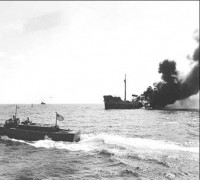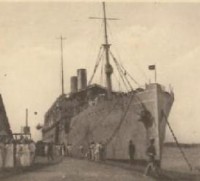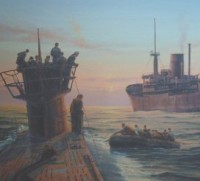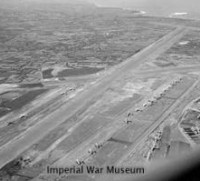- THE HARD ROAD TO WAR
6)DEFENSE PLANNING AND FEB
In the spring of 1942 the United States Army had anticipated that the principal business of the commission about to be established in Washington would be the drafting of a detailed plan for the joint defense of northern Brazil by United States and Brazilian forces. The commission began work on the defense plan in August 1942, but before it completed the plan in January 1943 the United States no longer wanted to put any of its own ground or air combat units into Brazil.
The defense plan, embodied in the commission's Recommendation No. 14 of 20 January 1943, provided for a ground garrison for northern Brazil to consist of three infantry divisions, one armored division, eleven antiaircraft regiments, and eleven coast artillery battalions--all to be Brazilian troop units. The plan stated that the units were to be equipped by the United States with modern material to be furnished under lend-lease.
The commission itself recognized that the forces proposed were larger than actually needed for defense purposes, but it pointed out that these units, when properly equipped and trained, could eventually collaborate with United States forces in overseas combat operations.On General Ord's informal recommendation, the Operations Division and the Chief of Staff approved the new defense plan in principle, subject to the qualification that the United States should not plan to equip more than the three infantry divisions and three antiaircraft regiments.
Actually, of course, northern Brazil no longer needed a defense force of the size recommended by the joint defense commission, nor was the United States as yet prepared to furnish modern combat equipment for three Brazilian infantry divisions. What lay behind the recommendation was Brazil's desire to play an active combat role in the war overseas. The Brazilians had manifested this desire soon after their declaration of war, and during the fall of 1942 some Brazilian Army officers were urging an independent operation against Vichy-controlled French Guiana, or even Dakar. Immediately after the North African landings the United States War Department began to investigate the possibility of using a Brazilian unit in that theater.
The Department of State wanted a Brazilian battalion sent to North Africa, but the Army, after studying the problem, "demurred on the grounds that the sending of Brazilians would make necessary 'the sending of other Latin American troops, and that none could be sent before they [were] . . . supplied, reequipped, and properly trained." It was presumably in consequence of President Roosevelt's conversation with President Vargas at Natal on 28 January 1943 that the Army reversed its position and supported the employment of Brazilian troops abroad. Thus, when President Vargas and General Carvalho in April informally presented a plan for a four-division expeditionary force, General Marshall agreed; in early May, the United States Joint Chiefs of Staff approved the plan in principle.
The Army then sent General Ord to Brazil to arrange its details. As a result the United States in the summer of 1943 agreed to send 50 percent of the equipment for one infantry division to Brazil, where it was to be used to train Brazilian divisions in rotation. The Brazilian troops that were sent overseas were to be re-equipped by the United States in the theater of operations.
General Ord returned to the United States in June 1943 with the conviction that Brazil had a fixed intention to participate in the fighting overseas and that it had a real army that would fight well if given four to eight months of modernized training with proper equipment. Also, he reported that President Vargas had agreed to accept and follow the strategic direction of the United States in the employment of Brazilian forces overseas, and that General Dutra, the Minister of War, had asked that Brazilian units serve under United States high command in the theater to which they were sent. By its Recommendation No. 16 of 16 August 1943, the joint Brazil-United States Defense Commission formally launched the Brazilian Expeditionary Force.
After extensive training under the supervision of the Rio Military Commission, Brazilian troops began to move overseas in June 1944. Considering the circumstances of their training, movement, and equipment, the twenty-five thousand Brazilian ground forces and the air squadron that saw active service in the Italian theater between September 1944 and May 1945 acquitted themselves as well as General Ord had forecast they would. In consequence of its large and active role as a participant in the war, Brazil received the lion's share of the ground and air equipment distributed by the United States among the Latin American nations during World War II. The value of lend-lease material assigned by the War Department to Brazil reached $77,000,000 by August 1943, a total that included principally the munitions promised in the spring of 1942 and the initial equipment needed to train the Brazilian expeditionary forces.

The picture above shows a batch of US made guns when arriving at Rio de Janeiro harbor. The contract with the Americans included the purchase of 137 cannons destined for coast artillery and dated February 26, 1940, although negotiations began in September 1939.
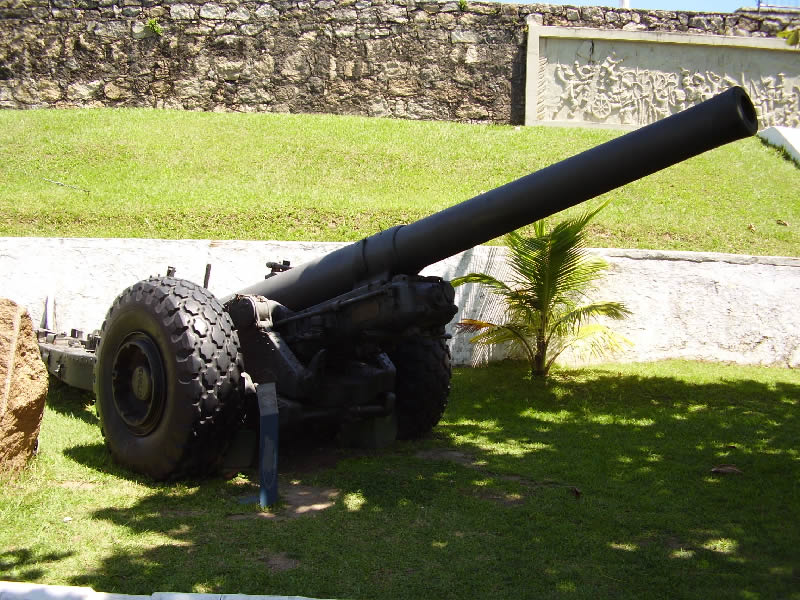
Above Vickers Armstrong Artillery Gun Model XIX 152.4mm. Manufactured in England by Vickers Armstrong in 1918. It was purchased from the USA by the Brazilian Army in 1940.
By the end of the war the value of Army wartime deliveries to Brazil under the lend-lease agreement of 3 March 1942 amounted to about $230,000,000, considerably more than that agreement had promised and more than twice the total value of all other Army lend-lease deliveries to the Latin American nations. The value of all lend-lease aid rendered to Brazil during and after the war amounted eventually to about $366,000,000, approximately three fourths of the total amount of assistance given to all of the Latin American republics together.
Preparations for the reduction and close-out of Army operations in Brazil began in March 1945. During the summer, activity along the string of air bases temporarily increased as soldiers were redeployed by air from the European and Mediterranean theaters, but this operation came to an end soon after Japan's surrender.
On 31 October 1945 the Army inactivated its theater organization, the United States Army Forces South Atlantic, and its few remaining troops were turned over to the South Atlantic Wing of the Air Transport Command. The Navy had already withdrawn from Brazil, and in the autumn of 1945 the Air Transport Command was also preparing to close out most of its activities, although negotiations were in progress to determine the future use of Brazilian air base facilities.The joint commissions that had been established in Washington and Rio de Janeiro in 1942 were retained after the war as instruments for military collaboration between the two nations in a troubled postwar world.
The wartime military partnership of the United States and Brazil paid rich dividends to both nations. Brazil's armed forces were greatly strengthened, both by American armaments and training assistance and by their own active participation in the fighting. From Brazil the United States received large quantities of materials, several types of which were vital to the successful prosecution of the war.
In collaboration with Brazilian naval and air forces, the United States Navy used Brazilian bases to cleanse the South Atlantic of German submarines and to blockade it against the shipment of war materials to or between the Axis nations. The airway through Brazil, which the United States was permitted to use freely and virtually without restriction after 1941 for military purposes, was one of the vital links with victory in the war.
Above all, the defense arrangements between the United States and Brazil, the largest and most strategically located of the Latin American republics, helped immeasurably in maintaining the stability of the Western Hemisphere nations against Axis machinations, and, until the Allied landings in North Africa in late 1942, these arrangements provided prime insurance against a German invasion of the New World.
Transcribed by Patrick Clancey – Hyper War Foundation
